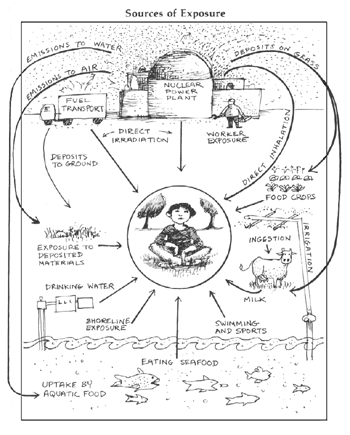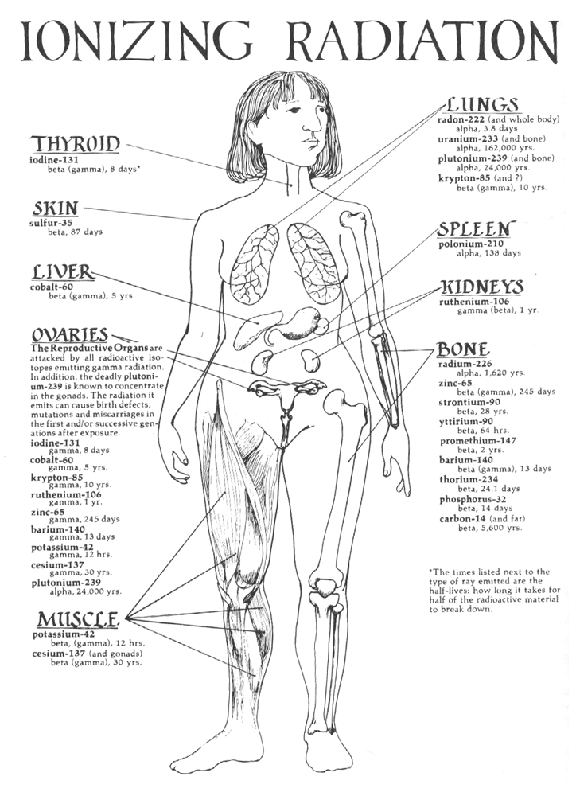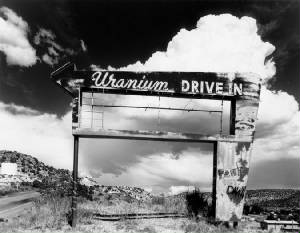|

|
| Copyright 2004 Mercy E. Van Vlack |
Environmental Consequences
The production of nuclear weapons has polluted vast amounts of soil and water at
hundreds of nuclear weapons facilities all over the world. Many of the substances released, including plutonium, uranium,
strontium, cesium, benzene, polychlorinated biphenyls (PCBs), mercury and cyanide, are carcinogenic and/or mutagenic and remain
hazardous for thousands, some for hundreds of thousands, of years. Contaminants from nuclear weapons production and testing
have often travelled far down wind and down stream. Production facilities for nuclear weapons are heavily polluted, for example
in the United States there are over 4500 contaminated Department of Energy sites.
The manufacture and testing of weapons involves the leakage of nuclear material. Of
all the activities concerning nuclear weapons, testing has been the most destructive of the environment. Even placing tests
underground does not avoid atmospheric pollution. Radioactivity released from atmospheric nuclear testing - including plutonium,
strontium, cesium, carbon-14, and radioactive iodine - has been widely dispersed throughout the world. Underground tests have
contaminated soil and groundwater. Many square miles in Russia, Belarus and the US have been rendered unusable by contamination
of the soil. Also the Irish sea and the Arctic Ocean have been poisoned.
In Russia nuclear submarines, some still armed with nuclear warheads, are rusting
away in the fjords of Murmansk. Elsewhere, rivers have been polluted and open reservoirs and lakes have been used to hold
large quantities of liquid radioactive materials. In 1957, a waste storage tank at the Chelyabinsk nuclear weapons site in
Russia exploded and a radioactive cloud dispersed over more than 200 square kilometres of an agricultural region containing
numerous rivers and lakes. Nearly all the trees within the most radioactive zone were damaged or killed. Radioactive waste
has been routinely dumped into Lake Karachay, recognized as the world's most radioactive body of water, also at Chelyabinsk.
The environmental damage resulting from nuclear technology is not limited to the two
largest nuclear weapons states, the United states and Russia. All nuclear weapons and nuclear energy producing nations have
caused some level of environmental contamination, both in their own countries and abroad - such as, nuclear testing in the
South Pacific, Nevada, Kazakhstan, China, India and Pakistan; water and airborne discharges from reprocessing plants in the
UK and France; and uranium mining in Namibia, Canada, former East Germany and Australia.
Moreover, the ongoing production of both nuclear weapons and nuclear power continues
to create nuclear waste. The mining of uranium causes radioactive pollution of the atmosphere and also otherwise damages the
environment. Further pollution occurs during the transport and processing of the uranium. Production of nuclear weapons involves
the generation of large quantities of waste material and contamination of surrounding areas. Clean-up of contaminated sites,
disposition of excess fissile material and dismantling of nuclear weapons also contaminates the environment. New technologies
will need to be developed in order to retrieve radioactive materials which have been released into the environment either
through accident or by design. Nuclear warfare would result in the wholesale destruction of the environment.
The burial of radioactive materials is presently being promoted as the solution to
radioactive waste disposal. However, at present, there are no known disposal routes for long-lived radioactive materials.
The burial of these materials must not be confused with their safe containment and isolation from the environment. Whether
the storage containers, the store itself, or the surrounding rocks will offer enough protection to stop radioactivity from
escaping in the long term is impossible to predict. One of the most likely mechanisms of pollution in connection with waste
disposal in rock is the contamination of groundwater. Underground waters may come into contact with radioactive elements that
have leached out from the waste and contaminate the drinking water of both local and distant communities.
Health Consequences
"In the dim light of a hospital room, seven years old Jimmy was remembering the
day on which he was told he had leukaemia. He remembered his mother's tears, his father's bewildered anger, the alien feeling
of the hospital's environment. His mind replayed the nausea and the diarrhoea caused by radiation therapy and chemotherapy,
his hair falling out and kids laughing at him... Jimmy died gently, utterly exhausted having lost so much blood. His tissue
had broken down completely, and he was bleeding from every body opening . His bed looked like a battlefield."
"On August 9, 1945, when the atomic bomb was dropped over the city of Nagasaki,
Kasuko Yamashina was working at a distance of two kilometers from ground zero. He tried to get home after the dropping of
the bomb, but the fire was too fierce for him to approach the district, so that night he had to sleep under a bridge alone.
His house was located at a place situated about 350 metres from ground zero. As soon as the fire went down, he reached the
house finding out that his parents were burned by the heat of 4,000 degrees and lay scorched black and carbonised. He couldn't
find his brother and his sister, and all that he could see were burned bricks and dead bodies.
On the August 15, the war was over, but by that day Kasuko's body had changed. He had black bleeding from the gums, and he
wasn't able to walk because of fierce shivers caused by high fever.
Under that condition
he left Nagasaki to enter a hospital in his home town.
On 19th September, the headquarters of General Mac Arthur set up
a press code, ordering him and the other victims never to speak about the atomic bombs. They announced that all the persons
who should die of radiation efects, would die by December 1945. Those who would live at that time, would have been spared
by radiation.The situation of radiation injuries was unknown at that time, even in Japan. Only in 1957, the Supporting Law
of Atomic Victims was passed, and Kasuko was legally admitted as a Hibakusha, but he had to conceal his being in order to
survive.
In 1963 he had a high fever, his body changed stiff and black. It took him
three years to get back his original skin colour, and, during the nights, Kasuko was extremely scared, he heard the voices
of the dead..."

|
| Copyright 2004 Mercy E. Van Vlack |
Jimmy and Kasuko's stories are two of the hundreds of thousands similar stories related to the nuclear age.
Radiation released from each step in the nuclear weapons production
cycle cause cancer, congenital defects, mental retardation, immune destruction, cancer, stillbirths and other health problems.
Similar syndromes have been observed among the workers exposed to radiation
in nuclear power plants in Japan, or in down-winders living in the irradiated zones near Hanford, and in the Chernobyl children,
as well as the areas close to the nuclear test sites.
In 1984 the United Nations Human Rights Committe noted that "it's evident
that the designing, testing, manifacture, possession and deployment of nuclear weapons are among the greatest threats to the
right to life which confront mankind today" and concluded that "the production, testing, possession, deployment and use of
nuclear weapon shold be prohibited and recognized as crimes against humanity."
In human terms the cost has been astronomical. Rosalie Bertel has estimated
that "the global victims of the radiation pollution related to nuclear weapon production, testing, use and waste conservatively
number 13 million."
Social Consequences
To understand the effects of a nuclear war it is important to distinguish it from
conventional war or a natural disaster. In particular, all the factors that would make it possible to cope with a normal emergency
situation would be lacking: limited damage, a relatively small number of casualties, surviving political or social leadership,
a desire to perform common emergency work rather than look after ones own family, large reservoirs of external, easily mobilized
skilled workers, material resources, and organizational skills.
The massive and simultaneous destruction of economic and human resources would result
in an inability to provide immediate and sufficient human and material aid to damaged areas. There will be no time to adapt
and to innovate as nations did in World War II. More importantly, the lack of outside aid would create a sense of individual
and common isolation. Aid symbolizes a reconnection with a larger, normal world. This connection helps provide the impetus
for rebuilding the damaged society, creating a sense of vitality and ability to dispel the continuing perception of isolation.
It also has an important function for binding together society, restating a common thread of hope and shared aspirations.

|
| When uranium mining went bust in the 1980's, many Colorado towns were economically devastated |
Economic destruction, loss of political leadership (especially at the local
level), and the need to mobilize resources for relief and recovery would present extraordinary demands on weakened political
institutions. In the interest of implementing survival programs, legal norms and practices would have to be suspended for
prolonged periods in many areas. The character of political institutions and authority would almost certainly change, especially
if hostilities or the threat of hostilities persisted. Both old and new political structures would be likely to suffer from
greatly reduced credibility. Decentralization of political power and more authoritarian methods of political, social, and
economic control would be probable responses to post-attack conditions.
However, even before any outbreak of nuclear war, the presence of nuclear weapons
has an enormous potential to distort social and economic priorities. Each of the nuclear weapons states has spent billions
of dollars on constructing, maintaining and protecting its nuclear weapons. It is not necessary to point out that this money
could have been better spent on providing health care, education or other public services.
The development of nuclear weapons also makes it necessary to create an unaccountable
"nuclear elite", made up of scientists, military and civil servants, who work largely in secret to control the development,
testing and deployment of nuclear weapons. This makes the presence of nuclear weapons incompatible with a democratic society.
It is possible to link an increased importance of the military, and a general increase
in militarism, to a growth of xenophobia, racial and religious intolerance, as well as male chauvinism.
|

